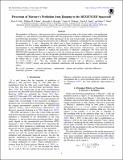Precession of Mercury’s Perihelion from Ranging to the MESSENGER Spacecraft
Author(s)
Park, Ryan S.; Folkner, William M.; Konopliv, Alexander S.; Williams, James G.; Zuber, Maria; Smith, David Edmund; ... Show more Show less
DownloadPark-2017-Precession of Mercury's Perihelion f.pdf (1.372Mb)
PUBLISHER_POLICY
Publisher Policy
Article is made available in accordance with the publisher's policy and may be subject to US copyright law. Please refer to the publisher's site for terms of use.
Terms of use
Metadata
Show full item recordAbstract
The perihelion of Mercury's orbit precesses due to perturbations from other solar system bodies, solar quadrupole moment (J [subscript 2]), and relativistic gravitational effects that are proportional to linear combinations of the parametrized post-Newtonian parameters β and γ. The orbits and masses of the solar system bodies are quite well known, and thus the uncertainty in recovering the precession rate of Mercury's perihelion is dominated by the uncertainties in the parameters J [subscript 2], β, and γ. Separating the effects due to these parameters is challenging since the secular precession rate has a linear dependence on each parameter. Here we use an analysis of radiometric range measurements to the MESSENGER (MErcury Surface, Space ENvironment, GEochemistry, and Ranging) spacecraft in orbit about Mercury to estimate the precession of Mercury's perihelion. We show that the MESSENGER ranging data allow us to measure not only the secular precession rate of Mercury's perihelion with substantially improved accuracy, but also the periodic perturbation in the argument of perihelion sensitive to β and γ. When combined with the γ estimate from a Shapiro delay experiment from the Cassini mission, we can decouple the effects due to β and J [subscript 2] and estimate both parameters, yielding (β -1)=(-2.7 ± 3.9) x 10[superscript -5] and J [subscript 2] = (2.25 ± 0.09) × 10[superscript −7]. We also estimate the total precession rate of Mercury's perihelion as 575.3100 ± 0.0015''/century and provide estimated contributions and uncertainties due to various perturbing effects.
Date issued
2017-02Department
Massachusetts Institute of Technology. Department of Earth, Atmospheric, and Planetary SciencesJournal
The Astronomical Journal
Publisher
IOP Publishing
Citation
Park, Ryan S. et al. “Precession of Mercury’s Perihelion from Ranging to the MESSENGER Spacecraft.” The Astronomical Journal 153.3 (2017): 121. © 2017 The American Astronomical Society
Version: Final published version
ISSN
1538-3881